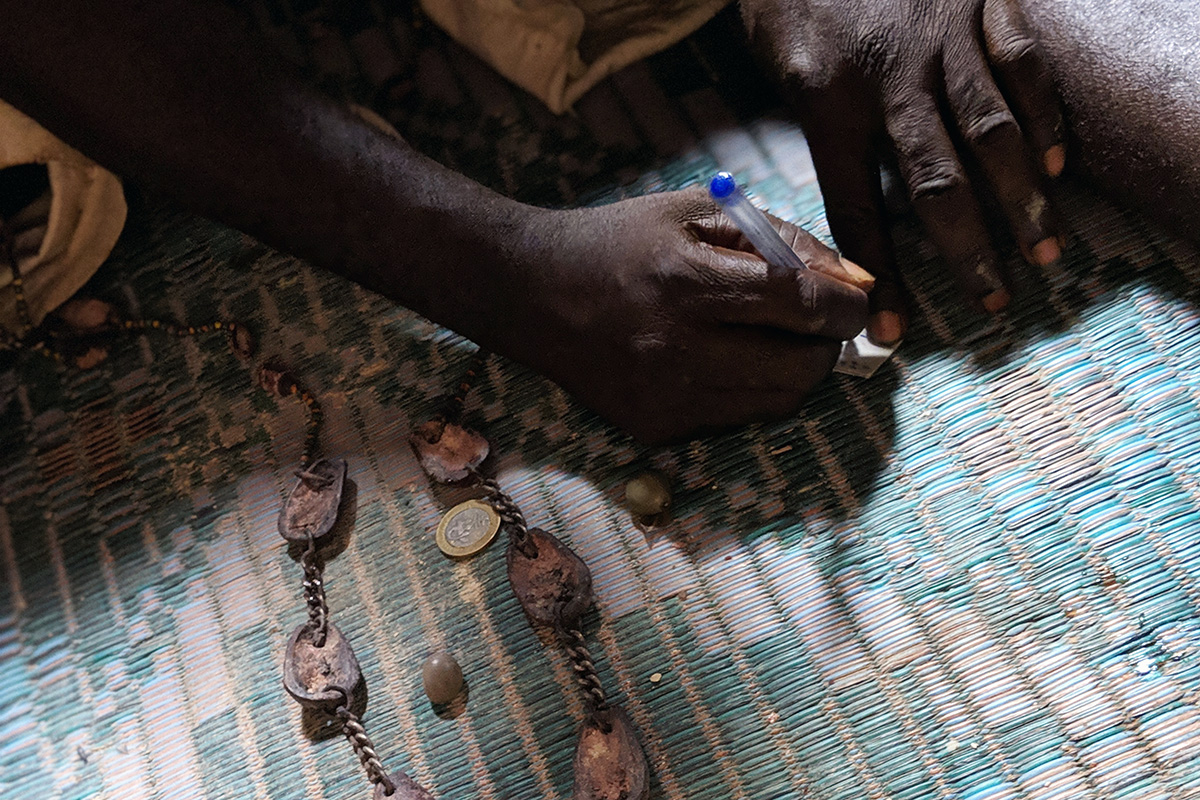An Introduction to Fa Divination of Benin

Fa diviner Koffi Akossa uses chains of kola nut pieces and other materials to gain insight into clients’ situations. Photo by Rebecca Fenton
In 2020, the Smithsonian Folklife Festival will feature a program about the West African nation of Benin and how communities connect to their environment through spirituality and traditional knowledge. Stay tuned for more research and stories from the program.
Across Africa, the practice of divination is a way of knowing that is widely used and widely varied. Many divination practices are connected to religious traditions, but they are also used to glean insight into all aspects of daily life.
In Vodun, a religion originating in coastal West Africa, Fa (also known as Ifa) divination is a key component of religious practice. In Benin, Fa is predominantly associated with two ethnic groups, the Fon and the Yoruba. Other variants of the system are found across the region, a result of its dynamic history.
In present-day Benin and Nigeria, Dahomey, a Fon kingdom founded in the seventeenth century, and Oyo, a Yoruba kingdom founded in the fourteenth century, were rival states. This rivalry resulted in a high degree of religious and cultural exchange between the Fon and Yoruba, with Dahomey making a conscious effort to incorporate Yoruba art, deities, and culture—including Ifa divination—into its existing set of beliefs. This accounts for the similarities in the two groups’ divination systems and the art surrounding the process.
Fa divination is intrinsically connected to the environment, using materials such as kola and palm nuts, palm oil, leaves, and flour, plus animal sacrifice. Some Vodun deities, also called vodun, are believed to manifest in objects found in nature, such as Fa, the divination spirit, who inhabits palm nuts; Heviesso/Shango, the thunder deity, who appears in thunderstones; or Legba/Elegba, the spirit of crossroads, who inhabits mounds of soil or even termite mounds.
People come to diviners for a medley of reasons, ranging from physical ailments to social or spiritual troubles. Fa divination retains its popularity because many believe it really works, and a consultation is not usually viewed as conflicting with other religious views, such as Christianity.
According to Koffi Thomas Akossi, a diviner in Ouidah, Benin, a diviner is like a guide. He explained that diviners can save lives by solving both spiritual and physical problems.

The Consultation Process
Contemporary Fa divination usually involves a divining chain, called an akplekan or an opele, after the seeds out of which it is made. The chain consists of eight linked seed halves and is shaped like a “U.” The diviner, called bokonon in Fongbe and babalawo in Yoruba, throws the chains to the ground, where they turn up in one of the 256 possible formations. Each of these corresponds with a du sign, which has a specific name and directs the diviner to a verse from the Odu Ifa, a body of divinatory literature that is typically passed down orally. The sign is determined by the diviner and named aloud, solidifying the results.
The other form of Fa divination involves fadekwin, or the sixteen sacred palm nuts. The nuts are tossed and caught systematically, and their positions are recorded on the divination boards, which are covered in a divination powder made of the irosun tree, or another plant powder, such as bamboo. Again, the du signs are recorded and named, referring to the relevant verses from the Odu Ifa.
Divination practices typically conclude with a sacrifice. Through sacrifice, bokonon are able to communicate with deities and manipulate ase—an intangible concept, sometimes described as “spirit” or “life force.” Everything has ase—people and animals, as well as vodun. Blood and divinity are linked concepts in Vodun, and the process of animal sacrifice is seen as a way to nourish both vodun and ancestral spirits, and as a way to share ase through the human consumption of the animal.
Blood is a nourishing force, one that builds community as it is shared between and among humans and spirits. The client purchases ingredients as determined by the diviner, and the diviner prepares and executes the sacrifice, accompanied by sung and chanted prayer. If an animal, typically a chicken or goat, is called for, its blood is spilled onto the altar of the vodun being invoked, along with other offerings such as palm oil, gin, flour, fruit, kola nuts, and even soda and candy. Sometimes, the meat is prepared and consumed by the bokonon and his client. Other times, sacrifices are distributed to the neighborhood or to nearby children, and this can be referred to as sara, deriving from Arabic for charity or alms.

Global Fa
Vodun has proven itself to be boundlessly adaptable and versatile, enabling it to spread across the world, due in large part to the diasporic effects of the transatlantic slave trade. Across the Atlantic, Fon, Yoruba, and other African systems of belief mixed with colonially imposed Catholicism, particularly by combining Roman Catholic saints and Fon vodun/Yoruba orisha, thereby enabling enslaved people to covertly continue their religious practices.
Fa divination and its variants have adapted to the needs of the diverse communities in which they are found. They are practiced in Haiti, Cuba, Brazil, and the United States as an aspect of religions such as Santeria, Voodoo, and Candomblé. Today, Ifa divination is recognized by UNESCO as Intangible Cultural Heritage, and bokonon have continued to adapt to and take advantage of technology, selling palm nuts and divining trays on Etsy and even performing divinations over WhatsApp.
Divination in Smithsonian Collections
These images, drawn from collections across the Smithsonian, explore the material culture of Fa divination and its natural and international connections. See more information about the objects on Learning Lab.
Megan Grabill is a research intern at the Smithsonian Folklife Festival and an anthropology and comparative studies major at Oberlin College.

